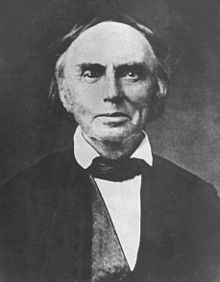Nicholas Longworth (winemaker)
Nicholas Longworth | |
|---|---|
 | |
| Born | January 16, 1783 |
| Died | February 10, 1863 (aged 80) |
| Resting place | Spring Grove Cemetery |
| Nationality | American |
| Occupation(s) | Lawyer, banker, real estate speculator, winemaker |
| Known for | Winemaking |
| Spouse | Susanna Howell |
| Children | Joseph Longworth Catharine Longworth Anderson |
Nicholas Longworth (January 16, 1783 – February 10, 1863) was an American real estate speculator and
Personal life
Longworth was born in
Nicholas pursued the study of law under Jacob Burnet, one of Cincinnati's first millionaires.[2] Early in his career he accepted plots of land as payment, which increased in value as Cincinnati grew, and by 1818 he quit being a lawyer to manage his real estate holdings.[1]
He was an abolitionist and his aid to a runaway slave was claimed to be inspiration for Uncle Tom's Cabin.[1]
Longworth was very invested in the arts. He made contact with every artist in Cincinnati between 1829-1858. He offered financial aid, letters of introduction, critique, and commissions.[3] He hired Robert S. Duncanson to paint eight large landscape murals in his home, which formally launched Duncanson's career.
His
Winemaking
Believing Cincinnati to be an ideal location for
The wines were also well received at home in the United States where
So successful was he that he has been called the Father of American Grape Culture. The growing tide of German immigrants coming down the Ohio Valley to Cincinnati liked his wine. Longworth had found a lucrative market: the new German immigrants wanted an affordable, drinkable table wine to continue with the traditions of their homeland, and he enjoyed a virtual monopoly.[7] With his success in wine making, Longworth participated in charitable giving throughout Cincinnati, including a noteworthy donation to the land which the Cincinnati Observatory is built on.[8] Besides being a pioneer and leading horticultural expert in his section, he was recognized as an authority in national horticultural matters. His writings, though individually short and now out of date, exercised a wide influence in his day.
His former vineyard is now Eden Park.
See also
- Sebastian Rentz (winemaker)
References
- ^ a b c Chambrun, Clara Longworth, comtesse de (1933). The making of Nicholas Longworth; annals of an American family. R. Long & R.R. Smith, Inc.
{{cite book}}: CS1 maint: multiple names: authors list (link) - ^ Burnet left an estate of about $2,000,000 when he died in 1853, according to The New York Times, "Cincinnati's rich men..." December 10, 1880.
- ^ a b Schwartz, Abby S. (1988). Nicholas Longworth: art patron of Cincinnati. Taft Museum.
- ISBN 9781467100021. Retrieved 2013-05-07.
- ISBN 9780738593951. Retrieved 2013-05-19.
- ^ a b B. Ramey The Great Wine Grapes Catawaba entry (no page numbers in book) University of California-Davis, 1977 ASIN B0006CZP4S
- ^ "Nicholas Longworth: Father of the American Wine Industry"
- ^ The Philanthropy Hall of Fame, Nicholas Longworth
